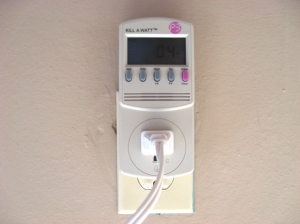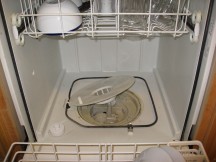 We finally got that Kill-A-Watt we’ve been thinking about, and we spent a good part of last weekend running around the house measuring the energy use of every single piece of electronic equipment we own. It was surprisingly fun. It was also a lot of numbers. (See below.) But we could draw a few conclusions from all of them: Continue reading
We finally got that Kill-A-Watt we’ve been thinking about, and we spent a good part of last weekend running around the house measuring the energy use of every single piece of electronic equipment we own. It was surprisingly fun. It was also a lot of numbers. (See below.) But we could draw a few conclusions from all of them: Continue reading
Author Archives: BrendaPike
The Least Toxic Way to Melt Snow & Ice

We had the season’s first real snowstorm this weekend, and we weren’t really prepared for it. I didn’t even know where our shovel was! We also didn’t have any salt for the front steps, so I took this opportunity to find out if we could get something that had less of an impact on the environment.
From what I can tell, there’s no truly environmentally friendly way to melt snow and ice. The two main materials people use—rock salt and calcium chloride—are both bad; it’s really just a choice of which is better. Along with many others, the City of Cambridge recommends using calcium chloride rather than rock salt or sand. (Ironically, the city also provides rock salt free of charge.) Many de-icers are a combination of multiple ingredients, so check the label. Here’s what I could find in local stores:
Rock Salt – NaCl (Sodium Chloride)
- toxic to plants and animals in high concentrations
- increases salinity of waterways
- corrosive to metal
- works best at temperatures above 20 degrees Fahrenheit
Magnesium Chloride – MgCl
- similar to calcium chloride below, but generally a liquid or additive to other de-icers (often rock salt)
- increases salinity of waterways
- less corrosive than rock salt
Calcium Chloride – CaCl2
- only half as much is needed (a handful per three square yards)
- works better than rock salt at temperatures below 20 degrees Fahrenheit
- increases salinity of waterways
Urea – (NH2)2CO
- adds ammonia to waterways
- increases algae blooms (much like fertilizer)
- works best at temperatures above 20 degrees Fahrenheit
Sand (Or Kitty Litter, Ashes, etc.)
- clogs sewers
- increases sedimentation in streams
- increases turbidity, reducing water quality and potentially killing fish and aquatic plants
- makes hard ice more slippery
- doesn’t melt ice
Calcium magnesium acetate and potassium acetate are two promising de-icers, but they’re generally only available for large-scale use or as additives to rock salt.
Since all ice melters have adverse effects on the environment, the best thing we can do is use less of them. To me, this means that calcium chloride is the way to go. It’s more effective in smaller amounts, and, if I could find the colored kind (I couldn’t around here), I’d be able to see the coverage and use less of it.
Keep in mind that these compounds are not supposed to take the place of shoveling, but break up the ice so we can shovel it away and prevent more skin from forming. That crunch under your feet is an indication that someone used waaay too much.
Cross-posted on pragmaticenvironmentalism.comThe Christmas Tree Conundrum: Real or Artificial?

For people who use real Christmas trees, the question comes up each year—should they switch to artificial? Our general rule is that reusable is better than disposable, but in this case, it’s not that simple.
The consensus (based on at least one peer-reviewed study) is that real trees are the way to go. Continue reading
Cross-posted on pragmaticenvironmentalism.comTo Save Energy, Use the Dishwasher?

This weekend we went on a cooking/cleaning binge, and one of the things that needed cleaning the most was the filter in our dishwasher. It was surprisingly easy to remove, but so disgusting that Jason and I took turns washing it out—neither of us wanted to deal with it for long. It definitely hasn’t been cleaned in the year we’ve lived in our apartment and, from the looks of it, for years before that, either. I didn’t even know it existed until I read Don’t Throw It Out!
Since the length of most dishwashers’ cycles depends on how much dirt they’re sensing coming off the dishes, cleaning the filter can make them more efficient. Although many newer dishwashers have self-cleaning filters, it should be one of the first things you check if your dishes aren’t getting completely clean.
I know what some of you are thinking: Why are you using the dishwasher in the first place? Isn’t washing dishes by hand more efficient?
People can be very proud of their particular dishwashing methods, but the best study to date, from the University of Bonn, has shown that a full dishwasher load washed by hand takes an average of 27 gallons. Even the most efficient handwashers used 8 gallons of water. By comparison, an Energy Star–qualified dishwasher uses less than 5.8 gallons per load.
Water conservation isn’t a big deal in the Northeast, but in this case the most energy is used in heating the water, so water consumption is a good yardstick. I probably wouldn’t run out to upgrade a five-year-old dishwasher just to improve its efficiency, but a 15-year-old dishwasher uses twice as much water as a new one. While some people argue that the production of the dishwasher makes it less efficient than handwashing, studies have shown that over a 15-year life cycle, energy use accounts for 95% of its environmental impact.
You could argue that with all the variables, it’s impossible to say exactly how your particular hand-washing stacks up to my particular dishwashing. But even with the benefit of the doubt given entirely to the by-hand proponents, it’s a wash, and in that case it’s much like the paper or plastic bag debate—not worth arguing about (except to say, use less of them). I’m not a big fan of handwashing dishes to begin with, so the dishwasher’s my choice. I’m just happy that my laziness is justified by facts.
Things we can do to make our dishwasher even more environmentally friendly include:
- Turn off the heat dry feature. If you feel like the dishes take too long to dry this way, open the dishwasher door slightly to let the air circulate.
- Turn your hot water heater down to 120 degrees if your dishwasher has its own heating element (most do).
- Don’t pre-rinse. Scrape instead.
- Run only full loads, but don’t overload. You want water getting to every inch of your dishes. (Seriously, I don’t know what the people in Rachel Getting Married were thinking.)
- Use a phosphate-free detergent. Phosphate runoff leads to algae blooms (much like nitrogen from fertilizers).
And, by the way, federal dishwasher standards are changing in January, and Energy Star standards are changing in July 2011, so if you’re planning on buying a new dishwasher, you might want to wait for the more efficient models. Check out Consumer Reports’ eco-site Greenerchoices.org for more buying tips.
Cross-posted on pragmaticenvironmentalism.com